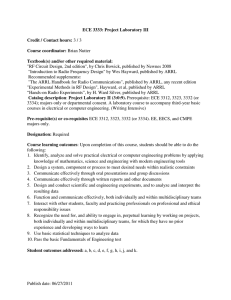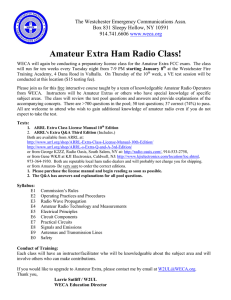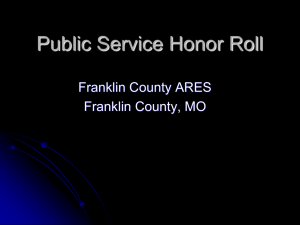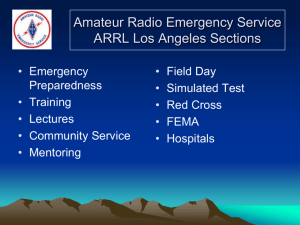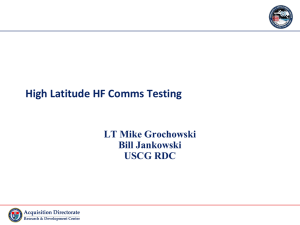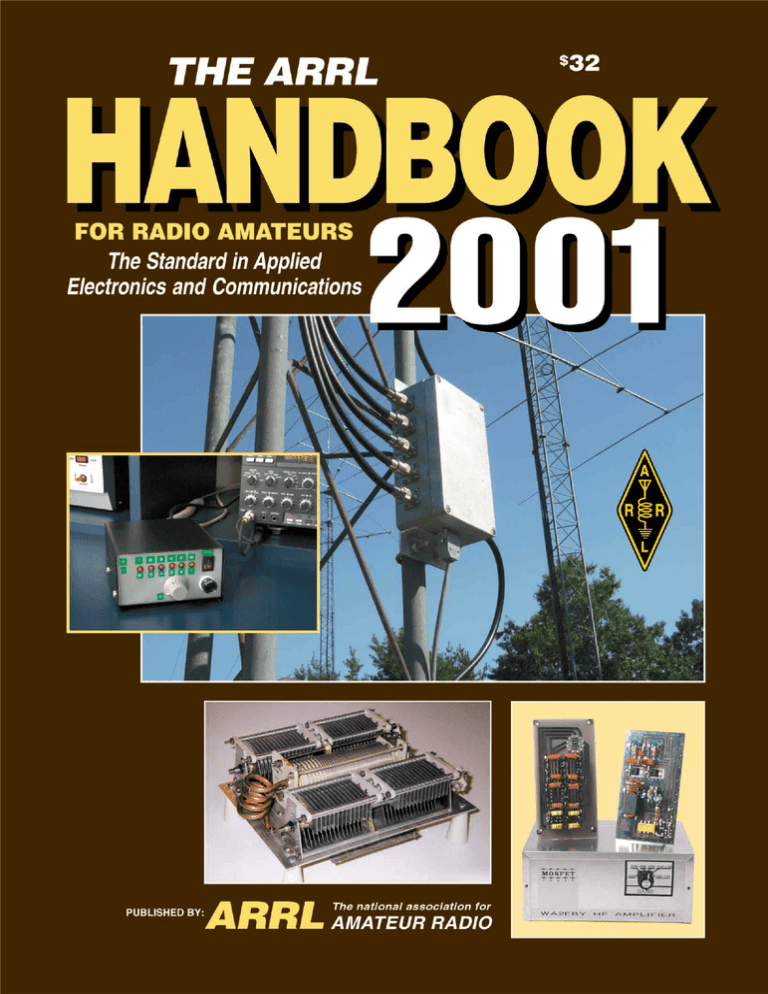
2001
The ARRL
Handbook
For Radio Amateurs
Editor
Chuck Hutchinson, K8CH
Contributing Editors
Joel Kleinman, N1BKE
R. Dean Straw, N6BV
Larry Wolfgang, WR1B
Technical Consultants
Ed Hare, W1RFI
Zack Lau, W1VT
Production
Michelle Bloom, WB1ENT
Sue Fagan, Cover
Jodi Morin, KA1JPA
David Pingree, N1NAS
Michael Daniels
Paul Lappen
Joe Shea
Proofreaders
Jayne Pratt-Lovelace
Edward J. Vibert
The Cover
Top: The antenna relay box for NJ1Q’s
Automatic Antenna Switch is perched on a
W1AW tower leg. The inset photo shows the
control unit. Read all about it in Chapter 22.
Photos courtesy of Joe Bottiglieri, AA1GW.
Bottom left: If you’re looking for power-handling
capacity, you’ve found the right tuner. N6BV’s
design works with both balanced and
unbalanced antenna systems. See Chapter 22.
Bottom right: WA2EBY’s all-band linear
amplifier uses low-cost MOSFETs. Details are
in Chapter 17.
Additional Contributors to
the 2001 Edition:
Dennis Bodson, W4PWF
Joe Carcia, NJ1Q
Steven Karty, N5SK
Tom O’Hara, W6ORG
William Sabin, W0IYH
Doug Smith, KF6DX
Ken Stuart, W3VVN
Bob Wolbert, K6XX
Seventy-Eighth Edition
A
R
R
L
i
Published by:
ARRL—the national association
for Amateur Radio
Newington, CT 06111 USA
Copyright © 2000 by
The American Radio Relay League, Inc.
Copyright secured under the PanAmerican Convention
International Copyright secured
This work is Publication no. 6 of the Radio
Amateur’s Library, published by the
ARRL. All rights reserved. No part of this
work may be reproduced in any form
except by written permission of the
publisher. All rights of translation are
reserved.
Printed in the USA
Quedan reservados todos los derechos
Printed Version: Seventy-Eighth Edition
Electronic Edition: Version 5.0
ISBN: 0-87259-188-3
ii
Contents
Introduction
1 What is Amateur Radio?
2 Activities
3 Modes
Fundamental Theory
4 Mathematics for Amateur Radio
5 DC Theory and Resistive Components
6 AC Theory and Reactive Components
7 Digital Signal Theory and Components
8 Analog Signal Theory and Components
Practical Design and Projects
9 Safety Practices
10 Real-World Component Characteristics
11 Power Supplies and Projects
12 Modulation Sources (What and How We Communicate)
13 RF Power Amplifiers and Projects
14 AC/RF Sources (Oscillators and Synthesizers)
15 Mixers, Modulators and Demodulators
16 Filters and Projects
17 Receivers, Transmitters, Transceivers and Projects
18 Digital Signal Processing
19 Transmission Lines
20 Antennas and Projects
21 Propagation
22 Station Setup and Accessory Projects
23 Repeaters, Satellites, EME and DFing
Construction Techniques
24 Component Data
25 Circuit Construction
26 Test Procedures and Projects
27 Troubleshooting and Repair
Operating Practices
28 Electromagnetic Interference (EMI)
29 Regulations
30 References
iii
Foreword
This 2001 edition of The ARRL Handbook continues the tradition begun by ARRL staff in 1926 of
publishing essential and useful technical information for radio amateurs. This volume represents the
work of many people, some of whom are listed on the title page. The authors and editors have put together
informative theory discussions as well as practical projects. Further, they have updated the References
chapter to make the book even more valuable to all hams (regardless of their areas of interest), technicians and engineers.
This year’s Handbook includes a new chapter on DSP by QEX editor Doug Smith, KF6DX. Doug
explains how this technology works, what it will do and where you might find it used in Amateur Radio
equipment.
Bob Wolbert, K6XX, wrote a new section on computer hardware for Chapter 7. With computers being
used increasingly in our installations, most of us should find this material very helpful. In addition, you’ll
find pin connections for most common computer connectors in the References chapter.
W1AW Manager Joe Carcia, NJ1Q, presents an automatic remote antenna switch in Chapter 22. The
automatic function works for Yaesu or ICOM radios, and manual control will work with any equipment
you might have.
In addition, there have been many updates throughout this book. In fact, most chapters have been
changed to provide you with the most up-to-date reference material available.
This is the 78th edition of The ARRL Handbook, and we’d like to think it’s the best ever. You can help
us make future editions even more useful by providing your comments and suggestions on the Feedback
Form elsewhere in this section.
David Sumner, K1ZZ
Executive Vice President
Newington, Connecticut
September 2000
iv
The Amateur’s Code
The Radio Amateur is:
CONSIDERATE…never knowingly operates in such a way as to lessen the pleasure
of others.
LOYAL…offers loyalty, encouragement and support to other amateurs, local clubs,
and the American Radio Relay League, through which Amateur Radio in the United
States is represented nationally and internationally.
PROGRESSIVE…with knowledge abreast of science, a well-built and efficient station
and operation above reproach.
FRIENDLY…slow and patient operating when requested; friendly advice and counsel
to the beginner; kindly assistance, cooperation and consideration for the interests of
others. These are the hallmarks of the amateur spirit.
BALANCED…radio is an avocation, never interfering with duties owed to family, job,
school or community.
PATRIOTIC…station and skill always ready for service to country and community.
— The original Amateur’s Code was written by Paul M. Segal, W9EEA, in 1928.
v
Schematic Symbols Used in Circuit Diagrams
vi
Handbook Software
The 1996 Edition was the first to include bundled software. The software proved to be a valuable
addition for many readers. On the other hand, bundling the disk with the printed book increased its cost.
A readership survey indicated clearly that keeping the cost of the book as low as possible was more
important than the bundled disk.
For this reason, we will again be making the software for the 2001 Edition available separately.
DOWNLOADING HANDBOOK SOFTWARE
You can download Handbook software from the Product Notes section of ARRLWeb: http://
www.arrl.org/notes/1867/. Simply click on Download hbk2001.exe. The Handbook software can also
be found on this CD, in the \software directory.
A description of the software appears elsewhere in this section.
The ARRL—At Your Service
ARRL Headquarters is open from 8 AM to 5 PM Eastern Time, Monday
through Friday, except holidays. Call toll free to join the ARRL or order ARRL
products: 1-888-277-5289 (US), M-F only, 8 AM to 8 PM Eastern Time.
If you have a question, try one of these Headquarters departments . . .
Joining ARRL
QST Delivery
Publication Orders
Regulatory Info
Exams
Educational Materials
Contests
Technical Questions
Awards
DXCC/VUCC
Advertising
Media Relations
QSL Service
Scholarships
Emergency Comm
Clubs
Hamfests
Telephone
860-594-0338
860-594-0338
860-594-0355
860-594-0236
860-594-0300
860-594-0301
860-594-0232
860-594-0214
860-594-0288
860-594-0234
860-594-0207
860-594-0328
860-594-0274
860-594-0230
860-594-0265
860-594-0267
860-594-0262
Electronic Mail
circulation@arrl.org
circulation@arrl.org
pubsales@arrl.org
reginfo@arrl.org
vec@arrl.org
ead@arrl.org
n1nd@arrl.org
tis@arrl.org
awards@arrl.org
dxcc@arrl.org
ads@arrl.org
newsmedia@arrl.org
buro@arrl.org
foundation@arrl.org
wv1x@arrl.org
clubs@arrl.org
hamfests@arrl.org
You can send e-mail to any ARRL Headquarters employee if you know his or her name or call sign.
The second half of every Headquarters e-mail address is @arrl.org. To create the first half, simply use
the person’s call sign. If you don’t know their call sign, use the first letter of their first name, followed
by their complete last name. For example, to send a message to John Hennessee, N1KB, Regulatory
Information Specialist, you could address it to jhennessee@arrl.org or N1KB@arrl.org.
If all else fails, send e-mail to hq@arrl.org and it will be routed to the right people or departments.
vii
Technical Information Server
If you have Internet e-mail capability, you can tap into the ARRL Technical Information Server,
otherwise known as the Info Server. To have user instructions and a handy index sent to you automatically, simply address an e-mail message to: info@arrl.org
Subject: Info Request
In the body of your message enter:
HELP
SEND INDEX
QUIT
ARRL on the World Wide Web
You’ll also find ARRLWeb at: http://www.arrl.org/
At the ARRL Web page you’ll find the latest W1AW bulletins, a hamfest calendar, exam schedules,
an on-line ARRL Publications Catalog and much more. We’re always adding new features to ARRLWeb,
so check it often!
Members-Only Web Site
As an ARRL member you enjoy exclusive access to our Members-Only Web site. Just point your
browser to http://www.arrl.org/members/ and you’ll open the door to benefits that you won’t find
anywhere else.
• Our on-line Web magazine, the ARRLWeb Extra with colorful news and features you won’t see in QST.
• QST Product Review Archive. Get copies of QST product reviews from 1980 to the present.
• QST/QEX searchable index (find that article you were looking for!)
• Previews of contest results and product reviews. See them here before they appear in QST!
• Access to your information in the ARRL membership database. Enter corrections or updates on line!
Stopping by for a visit?
We offer tours of Headquarters and W1AW at 9, 10 and 11 AM, and at 1, 2 and 3 PM, Monday to
Friday (except holidays). Special tour times may be arranged in advance. Bring your license and you can
operate W1AW anytime between 10 AM and noon, and 1 to 3:45 PM!
Would you like to write for QST?
We’re always looking for new material of interest to hams. Send a self-addressed, stamped envelope
(2 units of postage) and ask for a copy of the Author’s Guide. (It’s also available via the ARRL Info
Server, and via ARRLWeb at http://www.arrl.org/qst/aguide/)
Press Releases and New Products/Books
Send your press releases and new book announcements to the attention of the QST Editor (e-mail
qst@arrl.org). New product announcements should be sent to the Product Review Editor (e-mail
reviews@arrl.org).
Strays and Up Front
Send your Strays and Up Front materials to the QST Features Editor (e-mail upfront@arrl.org). Be
sure to include your name, address and daytime telephone number.
viii
ARRL Audio News
The best way to keep up with fast-moving events in the ham community is to listen to the ARRL Audio
News. It’s as close as your telephone at 860-594-0384, or on the Web at http://www.arrl.org/arrlletter/
audio/
Interested in Becoming a Ham?
Just pick up the telephone and call toll free 1-800-326-3942, or send e-mail to newham@arrl.org.
We’ll provide helpful advice on obtaining your Amateur Radio license, and we’ll be happy to send you
our informative Prospective Ham Package.
ix
ARRL Handbook CD Companion Software
Included on this CD-ROM is companion utility software that pertains to information and projects in
the Handbook or is generally useful to hams. To use the companion software, you need an IBM PCcompatible computer with approximately 3 MB of free hard-disk space if you want to install all of the
programs. The TISFIND and SVCFILT applications run only under Microsoft Windows or an equivalent
operating system. The others require DOS.
To install the companion software:
1) Close any open applications and insert the CD-ROM into your CD-ROM drive.
2) From the Windows Program Manager, select the File menu and choose Run. (For Windows 95 users,
click the Start button and choose Run.)
3) Type d:\software\setup.exe (where d: is the drive letter of your CD-ROM drive; if the CD-ROM
is a different drive on your system, type the appropriate letter) and press Enter.
4) Follow the instructions that appear on your screen.
The companion utility software Windows programs are located in the ARRL Handbook Programs
program group. The DOS programs can be found in the HBKSW directory on your hard drive (they may be
in a different directory if you specified one during installation). The programs are described in the following
section. See the Help file in the ARRL Handbook Programs program group for more information.
SOFTWARE DESCRIPTIONS
ACTFILT.EXE designs some simple active filters. See “Active Filters” in the Filters chapter for details
of the filters.
CONV.BAS runs the “PC Voltmeter and SWR Bridge” in the Station Accessories chapter. It accepts
analog input and sends the digital value to your computer printer port. FINDLPT.BAS helps you find
the addresses of the printer ports for use with the “PC Voltmeter and SWR Bridge” project.
CTL3DV2.DLL is a Windows DLL that may be needed with TISFIND. See TISFIND below.
DSP.EXE contains NWTNSQRT.BAS, a program that uses Newton’s method for determining square
roots; FSQRT.TXT, a machine-language routine for doing fast square roots and DSP.DOC, a file that
gives more information about the first two.
ELLER.EXE consists of program and support files to calculate placement and length for a coil-loaded
shortened dipole using an existing pair of inductors. See “Computer-Aided Design of Loaded ShortDoublet Antennas,” in the Antennas chapter.
INSTALL.EXE reads this file and installs the software on a hard disk. TISFIND requires a separate
installation under Windows. See instructions under TISFIND.
GRIDLOC.BAS converts latitude/longitude coordinates to four-character (such as FN42) grid square
locations. GRIDLOC.EXE is a compiled version of the .BAS program.
MORSE.EXE sends and receives CW. See “Quick and Easy CW with your PC” in the Station Accessories chapter for details.
SHADOW.EXE locates local true north in order to orient directional antennas. See “North Shadow” in
the Antennas and Projects chapter for details.
PWRSPLY.BAS calculates the characteristics of various power supplies and regulators. PWRSPLY.EXE
is a compiled version of the .BAS program.
PINET.EXE consists of several programs to aid design of Pi and Pi-L matching networks, as described
under “Tank Output Circuits” in the Amplifiers chapter.
PRODREV.ADB is the QST Product Review database, a comprehensive listing of reviews from 1970 to
the present. TISFIND.EXE (see below) is used to search this data.
README.TXT is the README file for the disk.
x
SAFETY.TXT consists of the complete list of RF Safety references.
SVCFILT.EXE is a program that designs passive element filters using standard value capacitors. A
complete help file is included.
TIS.EXE contains TISFIND.EXE (and related files), a Windows database look-up program used to view
databases distributed by ARRL. Included with TISFIND is the ARRL TIS Address Database, which
contains address and contact information for over 2000 companies and organizations of interest to
amateurs.
TLI.EXE contains the files TL.EXE and TL.DOC. TL.EXE computes many parameters for transmission
lines, as well as for antenna-tuners—including losses and stresses. See the Transmission Lines
chapter.
TUNER.TXT contains tables that show losses measured under various load conditions with the new highpower antenna tuner.
UTCZONE.BAS is a handy program that gives the UTC zone and time offset for each zone.
UTCZONE.EXE is a compiled version of the .BAS program.
VESTER_F.EXE contains the many files that make up the slow-scan TV system described in the Modulation Sources chapter. Be sure to read the README files.
xi
F E E D B A C K
Please use this form to give us your comments on this book and what you'd like to see in future editions, or e-mail us at
pubsfdbk@arrl.org (publications feedback). If you use e-mail, please include your name, call, e-mail address and the book
title, edition and printing in the body of your message. Also indicate whether or not you are an ARRL member.
Where did you purchase this book?
o From ARRL directly
o From an ARRL dealer
Is there a dealer who carries ARRL publications within:
o 5 miles
o 15 miles
o 30 miles of your location?
License class:
o Novice o Technician
o Technician with code
o Not sure.
o General
Name
o Advanced o Amateur Extra
ARRL member?
______________________________________________________________
Daytime Phone
(
) __________________________________________
o Yes o No
Call Sign __________________________
Age ______________________________
Address ____________________________________________________________________________________________
City, State/Province, ZIP/Postal Code ___________________________________________________________________
If licensed, how long? __________________________________
e-mail address: _____________________________
Other hobbies ___________________________________________________________
For ARRL use only
______________________________________________________________________
Occupation ____________________________________________________________
Edition
Printing
2001 HBK
78 79 80
1 2 3 4 5 6 7 8 9 10 11 12
From __________________________________
Please affix
postage. Post
Office will not
deliver without
postage.
_______________________________________
_______________________________________
EDITOR, ARRL HANDBOOK
ARRL—THE NATIONAL ASSOCIATION FOR AMATEUR RADIO
225 MAIN STREET
NEWINGTON CT 06111-1494
please fold and tape

